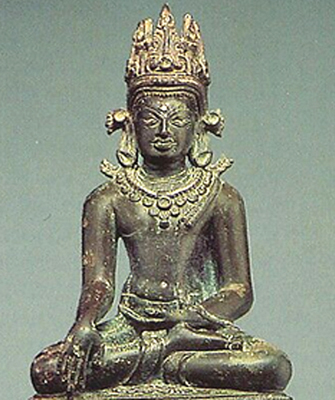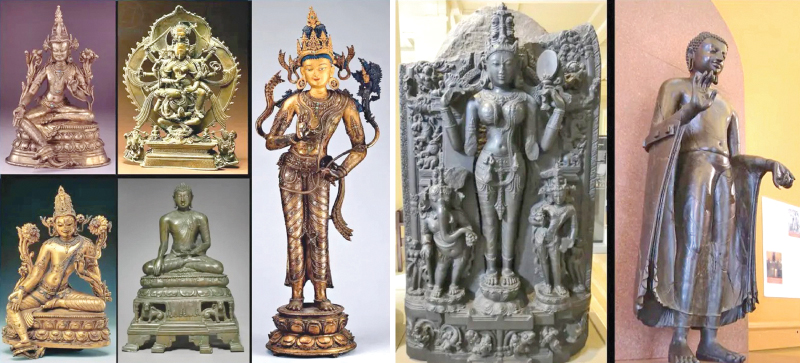The Buddhist Pala dynasty of Bengal held sway for 400 years, the longest period in the history of Indian Buddhism. The dynasty is also associated with Tantrik Buddhism and exquisite Buddhist sculptures.
Most of the literature on Buddhism in ancient India will be about the Magadha region in Bihar ruled by the Mauryas, of whom, Emperor Asoka was the most famous. Bengal, which covers present-day West Bengal State in India and Bangladesh, would be by-passed.
What is overlooked is that, among all the regions of India, it was in Bengal that Buddhism survived and flourished for the longest period of time (till the 12th Century CE), well after its disappearance from other parts of India.
The term “Bengal” as used here, includes what is now the Indian State of West Bengal and Bangladesh. This is because these two regions, which are presently politically distinct, share a long history, culture and language, despite the fact that West Bengal is predominantly Hindu and Bangladesh is Muslim.
Prof. Niru Kumar Chakma of the Department of Philosophy, University of Dhaka, Bangladesh, says in his paper on Bengali Buddhism (Bangladesh e-Journal of Sociology. Volume 8, Number 1. 2011) that Bengal has a unique place in Indian Buddhism. The reasons he cites are –
(1) It was in Bengal that Buddhism survived and flourished for the longest period (from the 8th to the 12th Century CE), well after its disappearance from other parts of India.
(2) Bengal is the home of “Tantrik Buddhism” which bloomed during the rule of the Pala dynasty (between the 9th and the 12th Century CE).
(3) It was because of the decline of the Pala dynasty that Buddhism was wiped out from India in the 12th Century.
However, Buddhism had a resurgence in the Eastern part of what is now Bangladesh much later. There is still a small minority of Buddhists in the Chittagong area, with ancient roots and links with Buddhist Myanmar.
Early period

The Buddha with a crown – Pala period sculpture
During the Buddha’s time (6th Century BCE), the prevailing faith was the Brahminical Vedic religion centred on rituals and sacrifices (a mixture of nature worship and animal sacrifice). The Buddha debunked these beliefs and practices as meaningless and unproductive. Buddhism heralded the beginning of systematic religious traditions in India.
The Magadhan Empire, which existed between 6th Century BCE and 8th Century CE, in what is now Bihar State in North India, heralded the emergence of strong monarchical States in place of small republics such as the Sakya republic of the Buddha’s time.
Emperor Asoka (268 to 232 BCE) belonged to Magadha. The Magadhan-era saw the beginning of the history of relations between the State and religion. The growth of a relationship between religion and the State was important because it helps explain the rise and fall of Buddhism in India.
Buddhism rested on State patronage. Withdrawal or weakening of royal or State patronage resulted in its decline. A strong and stable State structure enabled trade and commerce to flourish. The growth of the economy in turn helped sustain Buddhist monasteries and institutions. Conversely, the decline of the State and the economy led to the decline of monasteries and other Buddhist institutions.
Notable Dynastic supporters
The most notable Royal patrons in the “Buddhist era” were the following: King Bimbisara (543 to 492 BCE) and Ajatasatru (492 BCE to 462 BCE), and Asoka (268 to 232 BCE), all of Magadha; Kanishka (127 to 150 CE) of the Kushan dynasty; Harsavardhana of Thaneswar in what is now Haryana (590 CE to 647 CE) and the Palas of Bengal (8th to 12th Centuries CE).
“However, this is not to say that Buddhism received unflinching support from all Indian rulers even during the Buddhist era,” Prof. Chakmar says. Pushyamitra of the Sunga dynasty (185 to 75 BCE); Sasanka of the Gauda dynasty (590 and 625 CE), and the Senas of the 11th and 12th Centuries CE, were hostile to Buddhism.
Buddhism was firmly established in Bengal during Asoka’s rule in the 3rd Century BCE. Epigraphic and other sources such as the Asokan inscription in the Brahmi script found at Mahasthana in the district of Bogra (North central Bengladesh) give proof to that effect. The Chinese traveller, I-tsing or Yi-jing (635–713 CE) saw Asoka’s stupas in several places such as Tamralipti (Tamluk), Karnasuvarna in West Bengal, Pundravardhana in Northern Bengal, and Samatata in Eastern Bengal (now Bangladesh).
The Mauryan empire came to an end when its last emperor, according to Chinese traveller Huien Tsang (or Huanzang), Sasanka ordered the extermination of bhikkhus, cutting down of the Mahabodhi tree at Gaya, removal of the Buddha images from the Mahabodhi temple and replacing them with those of Siva. Brihadratha was killed by his commander-in-chief, Pushyamitra (185 BCE 149 BCE), the founder of the Sunga dynasty. This proved to be ruinous for Buddhism. Pushyamitra revived Brahmanical rituals and animal sacrifice with a vengeance and persecuted Buddhists. He was described by the Tibetan historian Taranatha as a tyrant.
However, historian R. C. Majumdar said that some Sunga kings had been quite tolerant of Buddhism. As evidence he pointed to the gateways constructed by the Sungas at Bharut and Sanchi, which were major Buddhist places of pilgrimage. Sanchi, Buddha Gaya and Saranath remained important Buddhist centres during the Sunga period. Further evidence of the Sungas’ support for Buddhism is in the form of the terracotta figurines discovered at various places in West Bengal.
The Guptas
The Buddhist history of India took a turn for the better with the establishment of the Gupta empire which spanned from the 4th Century CE to mid-6th Century CE. With Gupta rule came the political integration of much of India. Remarkable progress in every field of Indian culture was registered, making the Gupta period a “golden age” of Indian civilisation.
What was significant about Gupta rule in Bengal was that while Brahmanic Vaisnava and Saiva theisms were predominant, Buddhism was also flourishing. The reason was that the Guptas, while patronising Brahminism, accommodated Buddhism. One reason for this was that the Guptas began to consider the Buddha an avatar of Vishnu by the middle of the Sixth Century CE.
But the post-Gupta period had repression and persecution of Buddhism. Buddhists were persecuted by King Sasanka of Gauda. By contrast, Harsavardhana (606 to 647 CE) of Thaneswar (now Tanesar in Haryana State) rejuvenated and helped Buddhism emerge as a cultural force in India including Bengal. Harshavardhana is believed to have established his supremacy over Gauda (Northwestern Bengal) either after defeating Sasanka or taking it after Sasanka’s death.
Originally, a worshiper of Siva and Surya, Harsavardhana, like Ashoka and Kanishka, became a devout Buddhist. The contributions of Harsavardhana to Buddhism included building monasteries at Buddhist sacred places, erecting a thousand stupas on the banks of the Ganges, and banning the slaying of animals. His activities also included building hospitals and rest houses, construction of highways, planting trees and digging tanks and wells and, most importantly, convening conferences of Buddhist scholars.
Rise of Palas and Tantrik Buddhism
The next remarkable event in the history of Buddhism in Bengal was the rise of the Pala dynasty that ruled from the middle of the eighth Century CE to the latter half of the 12th Century CE. Pala rule brought political stability to Bengal. The Palas were also the last Buddhist dynasty to rule Bengal and the only dynasty in India to have reigned for 400 years.
Pala rule is held to be responsible for the rise of “Tantric Buddhism”. There are two lines of thought on Tantrik Buddhism. Prof. Chakma quotes Charles Eliot who branded Tantric Buddhism as “degenerate, decadent and corrupt”, and attributed it to Pala-rule in Bengal.
But Trevor Ling said that the Buddhism of the Pala period was no different from the classical Buddhism prevailing during the Asokan period in Magadha. Quoting Barrie Morrison, Suniti Kumar Chatterjee and Taranatha, Trevor Ling said that the Pala period was an era of progress in culture, religion, education, literature, art and sculpture. The Pala kings played a pioneering role in promoting the Bengali language and literature.
The earliest specimens of Bengali literature, known as Charya-padas, are a Tantric work of 22 Buddhist Tantric Acharyas known as Siddhas. As regards the origin of Tantrism, there are conflicting views. H. P. Sastri, P.C. Bagchi, and Wayman assign to it a Greco-Roman origin. But L.M. Joshi, Gopinath Kaviraja and John George Woodroffe trace Tantrism to pre-Buddhist religious practices in India. Other scholars, such as Moriz Winternitz, B.Bhattacharya and Sushil Kumar De, trace it to folk religions in Bengal, Assam, Odisha and Andhra Pradesh.
Tantric Buddhism emphasized mystic syllables (mantras), magical diagrams (yantras), ritualistic circles (mandalas), physical gestures (mudras) and spells (dharanis). There were other esoteric Tantrik practices too.

Pala era sculptures
The earliest form of Tantric Buddhism is believed to be Mantrayana, deriving its name from the word ‘mantra.’ In course of time, the cult assumed other forms, namely, Vajrayana, Sahajayana and Kalachakrayana. Tantric Buddhism eventually merged with Saktism with its focus on female worship.
The fusion of Buddhist mysticism with Saktism gave rise to popular cults, such as Kaula, Nathism, Avadhuta, Sahajiya and Baul. It is through these newer, marginal and folk religious movements, that Buddhist mysticism spread and survived for centuries in Bengal.
The Pala era may also be regarded as the golden age of Buddhism in Bengal. Copper-plates and inscriptions are evidence of Buddhism receiving lavish patronage from the Pala kings. The Palas established Buddhist schools, built the great Odantapuri Vihara, the Vikramsila Vihara, the Somapura Vihara at Paharpur in the Rajshahi district of Bangladesh . These Viharas facilitated the study of Buddhist philosophy.
The Vikramsila Vihara, which was transformed into a famous international centre of learning, attracted Tibetan scholars who wrote numerous books in Sanskrit and translated them into Tibetan. Pala rule came to an end with the death of its last king, Ramapala, and with it, Buddhism lost royal patronage for good.
Other reasons for Buddhism’s decline
There were other factors which led to Buddhism’s decline in Bengal as elsewhere in India. Buddhism had no rituals to satisfy the mundane aspirations of the common people. On the other hand, Brahmanical Hinduism had rituals which enabled people to face mundane problems and meet their mundane aspirations.
But the severest blow to Buddhism was delivered by Bakhtiyar Khilji, (1203 CE – 1206 CE), a Turkish soldier of fortune whose plundering raids led to the subjugation of Bihar and Bengal. The destruction of Buddhist monasteries and the killing of bhikkhus put an end to the Buddhist era.









